OUT1100 User Guide: Difference between revisions
No edit summary |
(→About) |
||
| Line 9: | Line 9: | ||
===About=== | ===About=== | ||
[[Image:OUT1100_About.jpg|link=|700px|center]] | |||
Connect four 5V digital outputs with the OUT1100. This Phidget is great for controlling LEDs, relays, and other logic-level electronics. You can control the average power by adjusting the duty cycle -- the feature is great for dimmable electronics such as LEDs or fans. | Connect four 5V digital outputs with the OUT1100. This Phidget is great for controlling LEDs, relays, and other logic-level electronics. You can control the average power by adjusting the duty cycle -- the feature is great for dimmable electronics such as LEDs or fans. | ||
Revision as of 21:24, 9 March 2021
Part 1: Setup
Part 2: Using Your Phidget
About
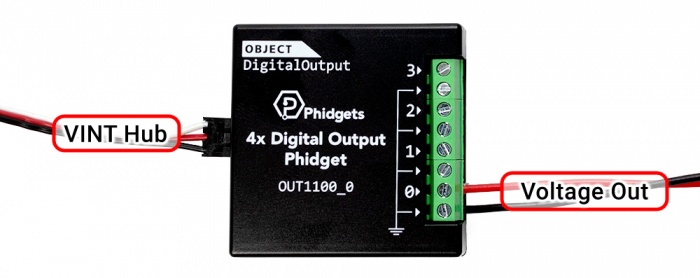
Connect four 5V digital outputs with the OUT1100. This Phidget is great for controlling LEDs, relays, and other logic-level electronics. You can control the average power by adjusting the duty cycle -- the feature is great for dimmable electronics such as LEDs or fans.
Explore Your Phidget Channels Using The Control Panel
You can use your Control Panel to explore your Phidget's channels.
1. Open your Control Panel, and you will find the following channels:
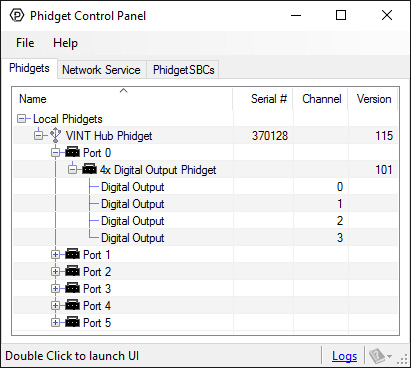
2. Double click on a channel to open an example program. Each channel belongs to the Digital Output channel class:
In your Control Panel, double click on "Digital Output":
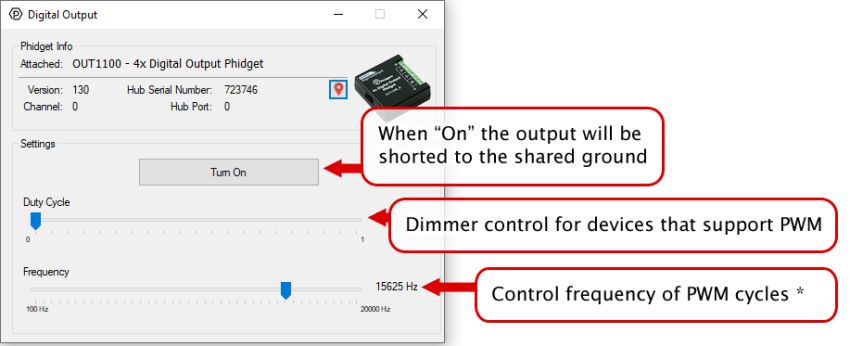
Part 3: Create your Program
Part 4: Advanced Topics and Troubleshooting
Before you open a Phidget channel in your program, you can set these properties to specify which channel to open. You can find this information through the Control Panel.
1. Open the Control Panel and double-click on the red map pin icon:

2. The Addressing Information window will open. Here you will find all the information you need to address your Phidget in your program.

See the Phidget22 API for your language to determine exact syntax for each property.
Starting from firmware version 110, using Phidget22 library versions 1.0.0.20190107 and later, this device supports the use of a failsafe feature to put your device in a safe state should your program hang or crash.
With this feature, each Digital Output channel on this device has its own independently settable failsafe timer.
If the failsafe is not enabled, the device will behave as it did before the addition of this feature, maintaining the last state or duty cycle it received until it is explicitly told to stop.
Enabling the failsafe feature for a channel starts a recurring failsafe timer. Once the failsafe timer is enabled, it must be reset within the specified time or the channel will enter a failsafe state. Resetting the failsafe timer will reload the timer with the specified failsafe time, starting when the message to reset the timer is received by the Phidget.
For example: if the failsafe is enabled with a failsafe time of 1000ms, you will have 1000ms to reset the failsafe timer. Every time the failsafe timer is reset, you will have 1000ms from that time to reset the failsafe again.
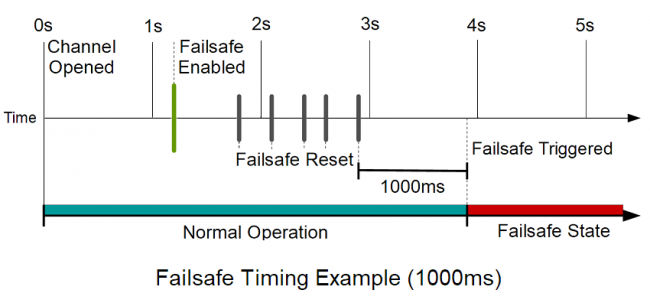
If the failsafe timer is not reset before it runs out, the channel will enter a failsafe state. For Digital Output channels, this sets the output to a FALSE state. On the OUT1100 this sets the output LOW. Once the channel enters the failsafe state, it will reject any further input until the channel is reopened.
To prevent the channel from falsely entering the failsafe state, we recommend resetting the failsafe timer as frequently as is practical for your applicaiton. A good rule of thumb is to not let more than a third of the failsafe time pass before resetting the timer.
Once the failsafe has been enabled, it cannot be disabled by any means other than closing and reopening the channel.
When you use a failsafe in your program, we strongly recommend setting up an error event handler to catch the Failsafe Error Event, to allow your program to catch the failsafe event.
If you want your program to try to automatically recover from a failsafe state, you can close and re-open the channel from the error event handler after determining a failsafe condition caused the event.
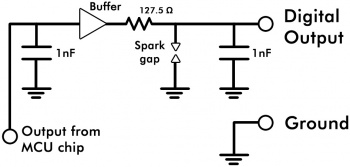
The digital outputs on the OUT1100 are slightly different from the digital outputs on other Phidget boards. This schematic shows the hardware on each of the OUT1000’s outputs.
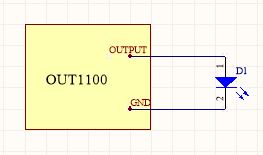
To drive an LED with the OUT1100, attach the anode to one of the digital output terminals, and the cathode to the corresponding ground terminal. The built-in series resistance will limit the current and keep the LED from burning out.

To control an SSR with the OUT1100, attach the SSR positive (+) terminal to the OUT1100 output terminal. Attach the OUT1100 ground terminal to the corresponding SSR ground terminal on the OUT1100.
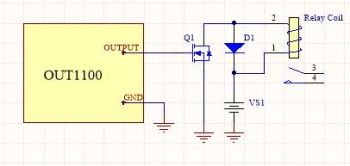
An inexpensive MOSFET and flyback diode circuit can be used to control larger loads (such as relays) from the OUT1100. Be sure to use a Logic-Level MOSFET so that the +5V Digital Output can turn it on. An NPN transistor could be used in place of the MOSFET, in cases where an NPN transistor may be easier to obtain.
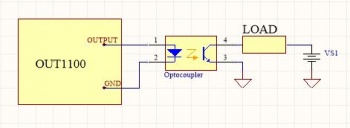
In applications where there is a lot of electrical noise (automotive), or in applications requiring maximum protection of the circuitry (interactive installations, kiosks), electrical isolation provides a large margin of protection. Take a look at the diagram. If the OUT1100 is switched on, it will power the LED, causing the phototransistor on the load side to activate. The maximum current through the transistor will depend in part on the characteristics of the optocoupler. Note that in cases where many isolated outputs are required, you may want to consider using the REL1100 or REL1101, which are ready-made isolated digital output Phidgets.
